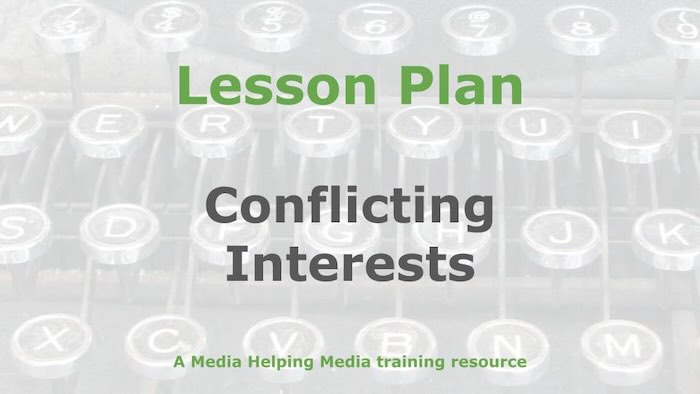 In journalism, public trust is essential for credibility. One of the most significant threats to that trust are the many possible conflicts of interest that might confront journalists.
In journalism, public trust is essential for credibility. One of the most significant threats to that trust are the many possible conflicts of interest that might confront journalists.
Any suggestion that personal, commercial, financial, political, or other external interests have shaped editorial decisions can severely damage the integrity of both the journalist and the news organisation.
Maintaining impartiality is not just a professional requirement; it’s a public service.
Why conflict of interest matters
Journalism exists to serve the public interest. When audiences suspect that a story has been influenced by a journalist’s personal agenda or financial gain, the legitimacy of the reporting is called into question. Even the appearance of a conflict can be enough to erode audience confidence.
Modern journalism demands transparency and accountability. As such, news organisations must develop rigorous standards and policies to identify, disclose, and manage potential conflicts. This includes both actual conflicts and situations that might be perceived as conflicts by the public.
Who is affected?
Everyone involved in the editorial process has a duty to uphold these standards. This includes:
- Presenters and reporters, who are the public face of the news.
- Editors and producers, who shape content behind the scenes.
- Researchers and contributors, who influence the framing and depth of stories.
- Managers, who set the ethical tone of the organisation.
The higher an individual’s editorial responsibility, the more important it is that they avoid even the appearance of any form of bias. Leadership must set the example, as their conduct reinforces or undermines the organisation’s credibility.
Typical conflicts of interest
Below are common situations where conflicts can arise. Each presents unique risks and requires careful handling:
- Writing for other news outlets: This could expose journalists to editorial pressures or expectations that conflict with their primary employer’s values or guidelines.
- Public speaking and appearances: Accepting paid or high-profile speaking engagements can blur the line between journalism and advocacy, especially when audiences associate the journalist with their reporting.
- Media PR training: Taking part in public relations (PR) training in order to teach others how to influence the media while also working as a journalist might be seen as compromising editorial integrity.
- Links to charities or advocacy groups: While well-intentioned, these connections can create perceptions of bias, especially if the journalist reports on issues related to their affiliations.
- Political involvement: Being an active member of a political party or campaign organisation can directly contradict the requirement for impartial reporting.
- Hospitality and gifts: Accepting meals, trips, or gifts from sources or interest groups risks compromising, or appearing to compromise, editorial independence.
- Business and financial interests: Holding investments or business ties in companies or industries that are covered by the journalist or outlet can lead to real or perceived bias.
Dealing with conflicts: best practices
- Disclosure: Journalists should be required to disclose any potential conflict of interest to their line managers. Transparency is a first step in assessing whether a conflict can be managed or avoided.
- Recusal: In some cases, the best solution is to remove the journalist from coverage that could be compromised by their personal interests or affiliations.
- Policies and training: News organisations should have clear, written guidelines regarding conflicts of interest, with regular training to ensure all staff understand expectations.
- Leadership by example: Senior editors and managers must model ethical behaviour, creating a culture where integrity is valued and ethical concerns are addressed openly.
- Editorial independence: Policies should explicitly guard against any influence from advertisers, sponsors, or political entities on editorial decisions.
Summing up
In today’s media environment – where journalists often build personal brands on social media and engage with audiences directly – boundaries between personal and professional roles are increasingly blurred. Newsrooms must continuously adapt to these changes, ensuring ethical standards evolve in step with new media practices.
At the heart of journalism lies a simple truth: the audience must believe in the integrity of what they read, watch, and hear. Maintaining strict standards around conflicts of interest isn’t just about compliance, it’s about earning and keeping public trust in a world where that trust is constantly under pressure.

Q&A: Conflicts of Interest in Journalism
Q1: Why is public trust considered so essential in journalism?
A1: Public trust is the absolute bedrock of credibility in journalism. Without it, the public’s faith in the information they receive crumbles, fundamentally undermining the purpose of news.
Q2: What is identified as one of the most significant threats to public trust in journalism?
A2: One of the most significant threats to public trust comes from the many possible conflicts of interest that journalists might encounter.
Q3: How can even the appearance of a conflict of interest impact a journalist or news organisation?
A3: Even the mere appearance of a conflict can be enough to severely damage the integrity of both the individual journalist and the news organisation, eroding audience confidence and questioning the legitimacy of reporting.
Q4: Beyond being a professional requirement, what is maintaining impartiality in journalism described as?
A4: Maintaining impartiality is described not just as a professional requirement, but as a fundamental public service.
Q5: Who within a news organisation has a duty to uphold the standards of avoiding conflicts of interest?
A5: Everyone involved in the editorial process has this duty, including presenters, reporters, editors, producers, researchers, contributors, and managers.
Q6: Can you give three examples of common situations where conflicts of interest might arise for journalists?
A6: Common situations include writing for other news outlets, accepting paid public speaking engagements, having links to charities or advocacy groups, political involvement, accepting hospitality and gifts, and holding business or financial interests in industries they cover. (Any three of these would suffice.)
Q7: What is the crucial first step in dealing with a potential conflict of interest, according to best practices?
A7: The crucial first step is disclosure; journalists should be obliged to reveal any potential conflict of interest to their line managers.
Q8: What is “recusal” as a method for managing conflicts of interest?
A8: Recusal means removing the journalist from coverage that could be compromised by their personal interests or affiliations.
Q9: Why is leadership by example particularly important when it comes to ethical behaviour in newsrooms?
A9: Leadership by example is important because the conduct of senior editors and managers either reinforces or undermines the organisation’s overall credibility and the culture where integrity is valued.
Q10: In today’s media environment, with journalists often building personal brands, what ongoing challenge do newsrooms face regarding ethical standards?
A10: Newsrooms must continuously adapt to these changes, ensuring their ethical standards evolve in step with new media practices, as the boundaries between personal and professional roles are increasingly blurred.
Lesson plan for trainers
If you are a trainer of journalists we have a free lesson plan: Conflicts of interest which you are welcome to download and adapt for your own purposes.
Related articles









